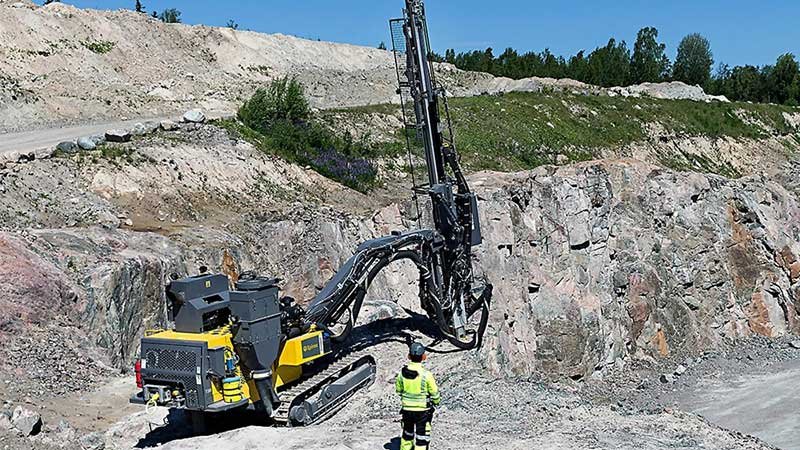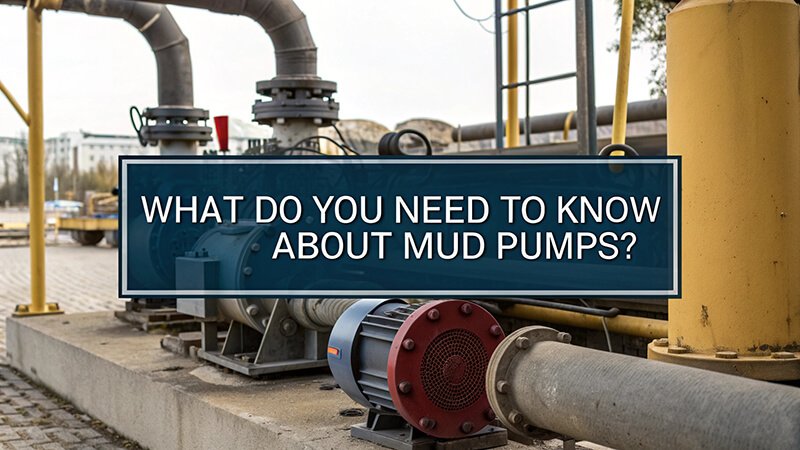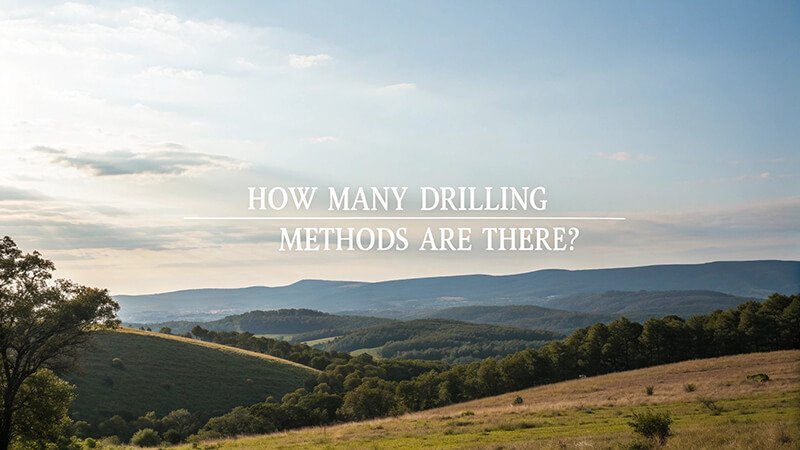Struggling with soil investigation challenges for your construction project? Inadequate geotechnical data can lead to structural failures, project delays, and budget overruns that could have been easily prevented with the right equipment.
A geotechnical drilling rig is specialized equipment designed to extract soil and rock samples from below ground surface for engineering analysis, featuring components specifically engineered for soil investigation, site characterization, and foundation testing across various terrains and project requirements.
At Hardrock, I've spent years developing geotechnical drilling solutions for clients worldwide. What makes these machines unique is their precision and adaptability. Unlike water well or oil drilling equipment, geotechnical rigs are built specifically to collect undisturbed samples that accurately represent subsurface conditions. This critical difference influences every aspect of their design, from the power systems to the sampling tools.
What Are the Main Components of a Geotechnical Drilling Rig?
Are you confused about what makes a geotechnical rig different from other drilling equipment? Without understanding the specialized components, you risk investing in machinery that can't deliver the precise soil data your project requires.
The main components of a geotechnical drilling rig include the power unit, mast/derrick, rotary head, feed system, control panel, hydraulic system, drilling fluid system, and various sampling tools specifically designed for undisturbed soil collection.
When I design geotechnical rigs at Hardrock, I focus on how each component contributes to sample quality and operational efficiency:
The power unit serves as the heart of the drilling rig, typically using diesel engines ranging from 40 to 200 horsepower depending on the rig size and capability. For urban projects with noise restrictions, we often incorporate sound dampening technology or electric power options. The power unit must be precisely matched to the rig's intended use – too little power leads to performance issues in dense soils, while oversized engines waste fuel and increase operating costs.
The mast or derrick provides the structural framework that supports the drilling operation. Unlike larger exploration rigs, geotechnical masts are designed for portability and quick setup, with heights typically ranging from 15 to 40 feet. Many of our models feature hydraulic raising systems that allow one operator to set up the mast in minutes. The mast must be engineered to maintain stability during sampling, as any vibration can disturb samples and compromise data quality.
The rotary head delivers the rotational force needed for drilling. Geotechnical applications require precise speed control, typically between 50-1000 RPM, with variable torque capabilities to handle different soil conditions. Our advanced rotary heads include torque limiters that prevent damage when encountering obstructions and electronic monitoring systems that help operators optimize drilling parameters for specific soil types.
The feed system controls the downward pressure and retraction of the drill string. This system must provide smooth, consistent movement to ensure sample quality. Modern geotechnical rigs feature hydraulic feed systems with adjustable pressure controls that allow operators to apply just enough force for effective drilling without sample disturbance. Feed rates can typically be adjusted from less than an inch per minute for delicate sampling to several feet per minute for faster advancement through known formations.
The control panel centralizes all rig operations, allowing the driller to monitor and adjust drilling parameters. Today's geotechnical rigs often feature computerized controls that record drilling data such as torque, penetration rate, and hydraulic pressure – valuable information that can be correlated with soil properties. Remote control capabilities are increasingly common, allowing operators to position themselves for optimal visibility and safety.
The hydraulic system powers most rig functions through a network of pumps, valves, and cylinders. Geotechnical rigs require exceptionally smooth hydraulic performance with precise pressure control. This is achieved through load-sensing hydraulic systems that adjust automatically to changing resistance. Modern systems also include cooling mechanisms to maintain optimal hydraulic fluid temperatures during continuous operation.
The drilling fluid system manages the circulation of drilling fluids that cool the bit, remove cuttings, and stabilize the borehole. For geotechnical applications, this system must be capable of switching between different drilling methods – from simple water circulation to polymer-enhanced fluids to air systems – depending on sampling requirements and ground conditions.
Sampling tools and accessories are perhaps the most specialized components of geotechnical rigs. These include:
- Thin-walled Shelby tubes for collecting undisturbed clay samples
- Split-spoon samplers for Standard Penetration Testing (SPT)
- Core barrels for rock sampling
- Dynamic and static cone penetrometers
- Specialized in-situ testing equipment
I remember working with a university research team that needed extremely undisturbed samples from varying depths. We equipped their rig with a custom-designed hydraulic system featuring ultra-precise pressure control and vibration dampening. The sampling system included specialized wire-line tools that could retrieve samples without withdrawing the entire drill string. This customization allowed them to collect research-quality samples that would have been impossible with standard equipment.
How Does a Geotechnical Drilling Rig Work?
Are you unsure about the actual drilling process and how it produces reliable soil data? Without understanding the operation principles, you might miss critical steps that ensure sample quality or waste time with inefficient drilling methods.
Geotechnical drilling rigs work by advancing drilling tools into the ground through rotation and downward pressure, using specialized sampling techniques to collect undisturbed soil or rock specimens while carefully monitoring drilling parameters to correlate with soil properties.
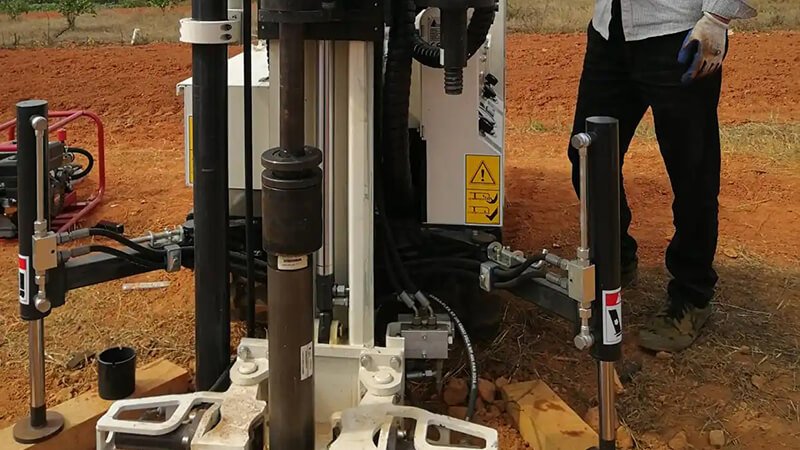
The geotechnical drilling process combines engineering precision with practical field techniques. Here's how our Hardrock rigs operate in real-world conditions:
Site setup and rig positioning begins the process. Unlike larger drilling operations, geotechnical investigations often require multiple shallow boreholes across a project site. Modern rigs feature self-propelled track or wheel systems for rapid repositioning. Many of our compact models can access confined spaces like building interiors or environmentally sensitive areas. Proper leveling is critical – even slight tilting can affect sample quality and test results. Most current rigs include hydraulic leveling jacks with electronic level indicators.
Drilling initiation starts with selecting the appropriate drilling method based on soil conditions and sampling requirements. Common methods include:
- Solid stem auger drilling for shallow, stable formations
- Hollow stem auger drilling when continuous sampling is needed
- Mud rotary for unstable soils or below groundwater
- Air rotary for consolidated formations
- Sonic drilling for difficult conditions requiring minimal disturbance
The driller carefully controls rotation speed and downward pressure, adjusting based on formation resistance. Modern rigs monitor these parameters continuously, with some systems automatically adjusting to maintain optimal drilling conditions.
Sample collection occurs at predetermined intervals or when soil conditions change. The drilling process pauses, and specialized sampling tools are lowered into the borehole. For standard penetration tests (SPT), a split-spoon sampler is driven into the soil at the bottom of the hole using a 140-pound hammer falling 30 inches. The number of hammer blows required to drive the sampler provides valuable data about soil density or consistency. For undisturbed samples, thin-walled tubes are hydraulically pushed into the soil without rotation or percussion.
Sample handling and preservation follows strict protocols to maintain sample integrity. Each sample is immediately labeled with depth, location, and orientation information. Special care is taken to seal samples to preserve moisture content and prevent contamination. Temperature-sensitive samples may require special handling procedures. Our advanced rigs often include on-board sample storage systems with climate control features for sensitive projects.
Borehole advancement continues after sampling, with the drill string rotating and advancing to the next sampling depth. Between samples, the driller carefully monitors drilling parameters like torque, rotation speed, and penetration rate, as these can indicate changing soil conditions. Many modern rigs record this data automatically, creating detailed drilling logs that supplement the physical samples.
In-situ testing may be conducted alongside sampling. These tests measure soil properties directly in the ground without removing samples. Common tests include:
- Vane shear tests for soft clay strength
- Pressure meter tests for soil deformation properties
- Permeability tests for groundwater characteristics
- Cone penetration testing for continuous soil profiling
Borehole completion involves either backfilling the hole with grout (for temporary investigations) or installing monitoring equipment like piezometers or inclinometers (for ongoing site monitoring). Environmental regulations often dictate specific completion methods, particularly when drilling has penetrated multiple aquifers.
I recently worked with a coastal infrastructure project where conventional drilling methods were disturbing the sensitive marine clay samples. We adapted one of our rigs with a specialized sonic drilling system that uses high-frequency vibrations to advance the drill string with minimal disturbance. This modification allowed the engineers to collect perfect samples that accurately represented the in-situ soil conditions, leading to a more economical foundation design that saved the project millions.
What Types of Geotechnical Drilling Rigs Are Available?
Do you find yourself overwhelmed by the variety of geotechnical drilling equipment on the market? Choosing the wrong rig type can result in equipment limitations that compromise your investigation or unnecessary expenses on capabilities you'll never use.
Geotechnical drilling rigs come in various configurations including truck-mounted, track-mounted, trailer-mounted, portable/modular, and specialty rigs, each designed for specific access conditions, drilling depths, and sampling requirements.
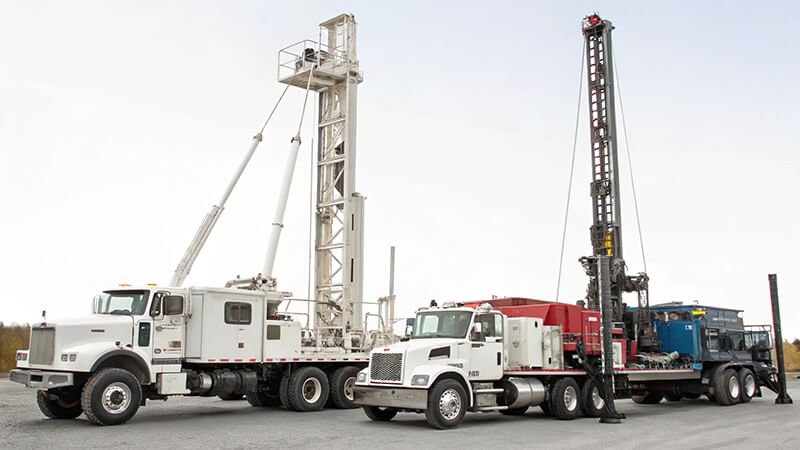
Here's my breakdown of the main types and their ideal applications:
Truck-mounted rigs offer excellent mobility between sites and substantial drilling capacity. These units have the entire drilling system installed on a commercial truck chassis, allowing for quick highway transport without additional permits in most cases. Modern truck rigs feature hydraulic outriggers for stability and may include onboard water tanks, mud pumps, and sample storage areas. These rigs typically offer drilling depths from 100 to 500 feet depending on the model.
Advantages:
- Rapid mobilization between distant sites
- Self-contained operation with onboard tools and supplies
- Comfortable operator position with weather protection
- Good depth capacity for most geotechnical applications
Limitations: - Require reasonable site access and firm ground
- Larger footprint than some alternatives
- Higher initial investment cost
- Limited in very steep terrain
Track-mounted rigs excel in challenging terrain and environmentally sensitive areas. These units utilize rubber or steel tracks similar to those on excavators, providing exceptional mobility in off-road conditions. Low ground pressure options minimize site disturbance, making these rigs ideal for wetlands or protected areas. Modern track rigs feature retractable masts for working under height restrictions and can often navigate slopes up to 30 degrees.
Advantages: - Superior off-road capability
- Access to remote locations
- Reduced site preparation requirements
- Generally smaller footprint than truck rigs
- Some models can fit through standard doorways for indoor work
Limitations: - Slower transportation between distant sites (typically require trailers)
- Usually less drilling depth capacity than truck rigs
- Higher maintenance costs for track systems
Trailer-mounted rigs balance mobility with lower investment costs. These units are mounted on highway-legal trailers and towed by separate vehicles. They offer significant versatility, as the tow vehicle can be used for other purposes when the rig is operating. Many trailer rigs feature detachable control panels that allow the operator to position themselves at the optimal viewing angle for challenging operations.
Advantages: - Lower initial cost than self-propelled options
- Easy transportation on highways
- Can be towed by various vehicles depending on size
- Good for operations with intermittent drilling needs
Limitations: - Require suitable tow vehicle
- Usually less powerful than dedicated truck or track rigs
- Site positioning can be more challenging
- Limited self-leveling capabilities
Portable/modular rigs address extreme access challenges. These systems break down into components that can be carried by hand, transported by helicopter, or even packed on animals for remote locations. Once on site, the components assemble into a functional drilling system. Modern portable rigs utilize lightweight materials like aircraft-grade aluminum and feature quick-connect hydraulic couplings for rapid assembly.
Advantages: - Access to locations impossible for conventional rigs
- Can pass through doorways, narrow trails, or dense vegetation
- Ideal for buildings, basements, tunnels, or wilderness areas
- Lower transportation costs to remote sites
Limitations: - Limited drilling depth and power
- More labor-intensive setup
- Slower drilling progress than larger rigs
- Limited onboard tool and supply storage
Specialty geotechnical rigs are designed for specific applications. These include: - Limited access rigs with ultra-compact dimensions for indoor work or congested urban sites
- Sonic drilling rigs that use high-frequency vibration to advance through difficult formations with minimal disturbance
- Amphibious rigs for wetland or shallow water investigations
- Directional drilling rigs for horizontal soil investigation under existing structures
- Combined CPT/drilling rigs that integrate cone penetration testing with conventional drilling capabilities
What Are the Applications of Geotechnical Drilling Rigs?
Are you uncertain whether a specialized geotechnical rig is necessary for your project? Without understanding the full range of applications, you might underestimate how these versatile machines can solve complex site investigation challenges across multiple industries.
Geotechnical drilling rigs are used for foundation design investigations, infrastructure projects, environmental site assessments, mining exploration, seismic hazard studies, slope stability analysis, groundwater monitoring, and specialized applications like archaeological investigations or forensic engineering.
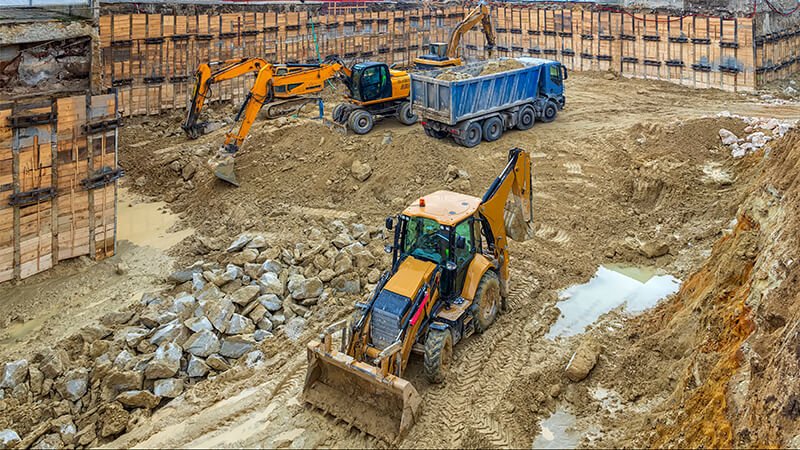
Based on my experience with Hardrock customers worldwide, here are the primary applications where geotechnical drilling proves essential:
Building foundation investigations form the core application for geotechnical drilling. These investigations determine soil bearing capacity, settlement potential, and foundation requirements. For high-rise structures, drilling may extend to bedrock or competent bearing strata. Samples collected help engineers determine:
- Foundation type (spread footings, piles, mats, etc.)
- Foundation depth requirements
- Potential settlement issues
- Soil improvement needs
- Construction dewatering requirements
Our rigs are routinely used for projects ranging from single-story commercial buildings to massive skyscrapers, where foundation costs can represent 15-20% of the total project budget. Proper geotechnical investigation often reduces foundation costs by allowing optimized designs based on actual soil conditions rather than conservative assumptions.
Infrastructure development relies heavily on geotechnical drilling, including:
- Road and highway construction – investigating subgrade conditions along proposed routes
- Bridge foundations – determining scour potential and foundation requirements
- Tunnel projects – characterizing ground conditions along the proposed alignment
- Dam construction – assessing foundation conditions and material properties
- Airport runways – evaluating subgrade uniformity and bearing capacity
- Railway corridors – investigating slope stability and subgrade conditions
These projects often require extensive drilling programs with dozens or even hundreds of boreholes. Modern geotechnical rigs with GPS integration and automated data logging have dramatically improved the efficiency of these large-scale investigations.
Environmental site assessments frequently utilize geotechnical drilling equipment, particularly for:
- Soil contamination investigations
- Groundwater sampling
- Installation of monitoring wells
- Remediation system installation
- Landfill gas monitoring
- Brownfield redevelopment assessment
For these applications, our rigs are often equipped with specialized sampling tools and decontamination systems. Many feature closed-circuit drilling capabilities that prevent cross-contamination between soil layers or aquifers.
Mining and resource development applications include:
- Pre-feasibility geotechnical studies
- Mine infrastructure foundation design
- Tailings dam safety investigations
- Pit wall stability assessment
- Underground mine support design
- Ore processing facility foundation design
These projects often involve challenging access conditions and remote locations where our track-mounted and portable rig options prove particularly valuable.
Natural hazard assessment is increasingly important as development expands into marginal lands. Applications include:
- Seismic hazard investigations
- Liquefaction potential studies
- Landslide assessment and monitoring
- Sinkhole and karst terrain investigation
- Coastal erosion studies
- Permafrost characterization
These specialized applications often require unique sampling techniques and in-situ testing capabilities. Our advanced rigs can be equipped with specialized tools like seismic cones, pressure meters, and inclinometers to collect critical hazard assessment data.
Water resources development relies on geotechnical drilling for:
- Aquifer characterization
- Monitoring well installation
- Pump test well construction
- Groundwater recharge studies
- Water quality investigations
Water resources development relies on geotechnical drilling for: - Aquifer characterization
- Monitoring well installation
- Pump test well construction
- Groundwater recharge studies
- Water quality investigations
- Sustainable yield assessments
While these applications overlap with water well drilling, the precision sampling and testing capabilities of geotechnical rigs provide the detailed data needed for comprehensive hydrological modeling. Our specialized rigs can switch between coring, sampling, and well installation functions to complete these multifaceted investigations efficiently.
Forensic engineering investigations employ geotechnical drilling to determine the causes of structural failures or unexpected ground behavior. These sensitive projects require exceptional sample quality and often involve drilling in and around damaged structures. Our compact rigs with low-vibration drilling capabilities are particularly suited for these delicate operations where preserving evidence is critical.
Research applications span numerous scientific fields including geology, archaeology, paleontology, and climate science. Academic institutions and research organizations often require specialized sampling techniques to recover materials for laboratory analysis. We've developed custom sampling systems for unique requirements like recovering undisturbed permafrost cores for climate research and collecting stratified sediment samples for archaeological dating.
I recently supplied a specialized geotechnical rig to a coastal engineering firm investigating sea level rise impacts. The amphibious rig could operate in the intertidal zone, collecting continuous samples that revealed historical storm surge deposits. This data helped calibrate coastal vulnerability models, allowing communities to develop more effective adaptation strategies. The project demonstrated how geotechnical drilling provides crucial data for addressing emerging environmental challenges.
Conclusion
Geotechnical drilling rigs are specialized machines designed to collect undisturbed soil samples and perform in-situ testing. With their unique components, precise operation methods, and diverse configurations, they provide the critical subsurface data needed for safe, efficient construction and infrastructure development across countless applications.



